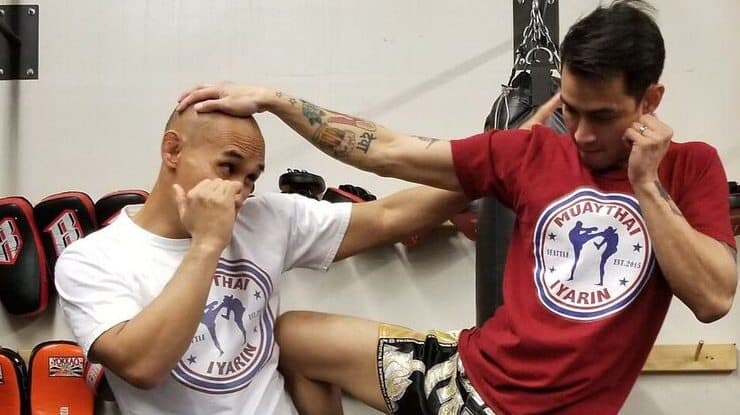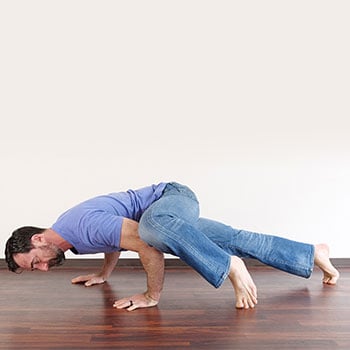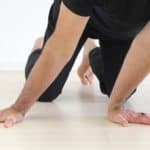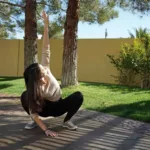The thrill of kicking and punching has gotten under your skin somehow, and now you can’t wait to get out of work and head to the gym to put on your handwraps and gloves and start hitting something!
 Muay Thai has made its way from its home country of Thailand and into gyms throughout the rest of the world. The “art of 8 limbs” (fists, elbows, knees, feet–2 of each) was originally used in war and then was developed into the national sport selling out big stadiums in Thailand and abroad.
Muay Thai has made its way from its home country of Thailand and into gyms throughout the rest of the world. The “art of 8 limbs” (fists, elbows, knees, feet–2 of each) was originally used in war and then was developed into the national sport selling out big stadiums in Thailand and abroad.
But what’s that got to do with GMB?
The obvious reason is it gives us a golden opportunity to pay homage to Jean-Claude Van Damme in Bloodsport, Jean-Claude Van Damme in Kickboxer, and Jean-Claude Van Damme in The Quest.
Beyond that, though, Muay Thai (and our varied experiences with it) is a perfect example of how GMB addresses the specific attributes that are often neglected in training–and how that translates to better performance, and fewer injuries.
If you want to reduce your chances of injury in your Muay Thai practice, this article will help.
And even if you have no interest in Muay Thai, kickboxing, or JCVD, the routine in this article targets areas that are commonly troublesome for many people. You can probably get a lot out of it no matter what you’re into.
In this article, we’ll cover:
- Common concerns for Muay Thai fighters
- Muay Thai + GMB: A love story
- A routine to improve mobility, balance, and control
- More ways to improve your practice
Our free Strength and Mobility Kickstart will help you move with more power and agility in your Muay Thai practice–and beyond.
Most Common Concerns if You Practice Muay Thai
Muay Thai is a stand-up combat sport that involves:

And that is a simplification of all that is involved in this highly technical sport. So, as you can imagine, there are many issues that can come up for a Muay Thai fighter. Here are the most common:
Flexibility Restrictions
If you struggle with tightness in your hip flexors, adductors, and/or hamstrings, kicking is going to be much more difficult.
And when this is going on, you will likely compensate in other ways, wasting energy to overcome stiffness in these areas. Wasted energy means you will move more slowly–and that’s no good in a sport that relies heavily on speed and power.
Limited Balance and Coordination
Balance and coordination are essential for pretty much every part of Muay Thai, but particularly for strikes and defense. If you don’t have great balance or coordination, you’re going to have a much harder time learning combinations and applying what you’ve learned in your drills to sparring sessions.
The routine below addresses both of these concerns, but you can also click to learn more about coordination and balance training.
Insufficient Resilience
Resilience refers to the ability to absorb and bounce back from unexpected forces on the body. This is a really important attribute to have if you’re practicing Muay Thai, since defending and attacking in a variety of situations can definitely place unexpected forces on your body.
If you’re not prepared for these forces, they can be injurious, and the last thing you want is to have to sit out your Muay Thai practice due to an injury.
Click here to learn more about resilience and why it’s so important.
How to Get Better at Muay Thai Kickboxing
 GMB Fitness programs have always emphasized improving your flexibility, strength, and body control in ways that you are likely not used to in your regular daily activities and in your other training in the gym.
GMB Fitness programs have always emphasized improving your flexibility, strength, and body control in ways that you are likely not used to in your regular daily activities and in your other training in the gym.
With a focus on the most commonly restricted issues in most people, you’ll see your weaknesses improve as you prioritize your time to work on them.
Many clients have reported that our targeted approach has helped them overcome restrictions and weaknesses that were holding them back in Muay Thai or other sports that emphasis striking and kicking. One client, Dena, said her kicking improved immensely after going through Mobility:

After watching GMB stuff for years now, I finally decided to try it out. I'm the tightest person you will ever find, with extremely limited mobility in every single area, which I only make worse by continuing to exercise despite of it. So I signed up a few weeks ago for Focused Flexibility and have been working through the exercises and have been finally starting to feel better.
My right roundhouse kick has been messed up for a few years due to limited hip mobility and I have noticed an improvement there which is awesome. Keep up the good work!
As you’ll see with the routine below, we’ve specifically chosen exercises that target practical concerns for anyone who does Muay Thai or other combat sports. In general, that is the name of the game with our programs: We want to make sure your efforts are specific to your needs, so you’re not wasting your time or energy.
And most importantly, especially when you’re practicing an intense art like Muay Thai, you want to make sure to balance out that intensity with movements that will protect you from injuries that could take you out of the game.
We’re No Strangers to Muay Thai!
Like quite a lot of kids, martial arts was something I decided to try, but unlike most people, it’s something that stayed with me and played a big part in shaping the rest of my life and my career.
I’ve explored a lot of arts over the years, and obtained instructorship rankings in a few.
I started learning the fundamentals of Muay Thai with my teacher Burton Richardson in Hawaii nearly 15 years ago, but it’s only in the last couple of years that I’ve devoted a lot of time to it here in Seattle with my Kru Tony Deva of Muaythai Iyarin.

Tony has taught me about Thai style training from his experiences as a fighter and as a coach for the National Thai team and his students here in the U.S. He and his wife, Iyarin, are fully focused on providing the best coaching and instruction for everyone interested in learning Muay Thai, whether they wish to compete or not.
He’s taken me under his wing, both for my own fighting skills and for training others. I’ve always tried to work hard in my training and practice, but have been lucky to have amazing teachers.
I’ve also gone through referee and judge certification courses with the World Boxing Council (WBC) and the US Muay Thai Federation (USMF), to further develop my understanding of the art and sport. It’s been a lot of fun cornering for our fighters, and putting on events to help grow the sport here in Washington.
Other members of our team have had experience with Muay Thai as well.

With my background in training and therapy, I’ve been able to develop and maintain my flexibility and balance and it helps quite a bit in learning and performing the many leg and knee attacks in Muay Thai, even at my ripe old age of 43.
Your “Secret Sauce” Muay Thai Mobility Routine
Most of the time in classes and training for Muay Thai is (rightfully) spent on technique, pad drills, conditioning, and sparring. Mobility and balance training are very important adjuncts to those, and it can be left up to you to do the work on your own.
Working on these areas outside of class is important for your overall performance.
The exercises in this routine specifically target the commonly tighter areas in our lower bodies, while combining balance, strength, and flexibility work for an efficient mobility routine.
Though this routine is geared toward Muay Thai and its specific positioning, working with this sequence will improve mobility for any striking fighting art and other sports which require balance on one leg while outstretched with the other.
Our free Strength and Mobility Kickstart will help you move with more power and agility in your Muay Thai practice–and beyond.
By practicing this routine regularly, you’ll see improvement in:
- Flexibility, strength, and control in the hip flexors
- Strength and balance in the ankles and feet
- Overall balance and coordination
- Better understanding of proper upper body positioning (specifically in the Lunge with Rotated Upper Body)
And that’s important because of all that goes into making your Muay Thai practice successful.

Let’s look at each of these exercises in detail.
Standing Knee to Chest
 This exercise helps with balance and control, while warming up the hips and knees for better mobility in these areas.
This exercise helps with balance and control, while warming up the hips and knees for better mobility in these areas.
- Stand tall and actively bring one knee up to your chest as high as you can, then assist even further with your hands.
- When you’ve lifted as high as you can, grasp your knee and shift your hips forward.
- Do 5 repetitions actively, then hold for 5 to 15 seconds, keeping your supporting leg as straight as possible. Then, switch to the other side.
Lunge to Standing to Knee
 This exercise is great for building strength and control. It’s a good warm-up for the hips, and helps with hip strength and mobility.
This exercise is great for building strength and control. It’s a good warm-up for the hips, and helps with hip strength and mobility.
- This is a Kneeling Lunge stretch combined with a knee strike motion. In the lunge, find your stability while also being in as long as a stance as you can (to also improve your hip flexibility).
- Control your rise to standing, as well as the knee strike.
- Your weight distribution should be on your front supporting leg as much as possible.
- Do 5 on one side, then switch to the other side.
Standing Forward Foot on Support Stretch
 This exercise targets flexibility in the hips and hamstrings.
This exercise targets flexibility in the hips and hamstrings.
- Face a stable support (one that won’t move!) and place your foot as high as you are comfortable with your knee able to bend ~40 degrees as you lean forward into the support. You’ll likely have to adjust your distance and your stance after a few repetitions to find what’s best for you.
- Once you’ve found the right positioning, slowly move into and out of the stretch 5 to 10 times, then hold the position of stretch for 10 to 30 seconds. Then, switch to the other side.
Front Scale with Hip Thrust
 This exercise works well for flexibility, balance, and control, and specifically targets flexibility and control in the hips and hamstrings.
This exercise works well for flexibility, balance, and control, and specifically targets flexibility and control in the hips and hamstrings.
- Start in a Front Scale, which involves having both legs locked out. If you can’t keep the knees locked out with the leg lifted straight out in front of you, then lower your foot until that’s possible.
- Maintain control and balance as you push your hips forward.
- Repeat 5 to 10 times, then hold the hips forward position for 5 to 10 seconds on your last repetition. Then, switch to the other side.
Standing Sideways Bent Leg on Support Stretch
 This stretch is all about improving flexibility in the hip adductors and hamstrings.
This stretch is all about improving flexibility in the hip adductors and hamstrings.
- Just as in the Standing Forward Foot on Support Stretch, you’ll use a stable support that won’t move when you place your weight on it.
- This time, face to the side of the support, and place your foot with that leg’s knee as bent as you comfortably can.
- Adjust your distance and positioning a couple of times until you find the best place, then move in and out of the stretch 5 to 10 times, holding the position of stretch on the last repetition for 10 to 30 seconds. Then, switch to the other side.
Standing Sideways Bent Leg Open Chain
 This exercise packs a big punch, and targets flexibility, balance, and control, all together, specifically in the hip adductors and hamstrings.
This exercise packs a big punch, and targets flexibility, balance, and control, all together, specifically in the hip adductors and hamstrings.
- This is a similar position to the previous exercise, but now without a support.
- Grab your knee with the same side hand and work on raising your knee up and out to the side as much as possible, actively and with assistance from your hand as you shift your pelvis to the side for more height and stretch.
- Repeat 5 to to 10 times and hold on the last repetition for 5 to 10 seconds. Then, switch to the other side.
Lunge with Rotated Torso Stretch
 This one will help you improve flexibility in your hips and torso.
This one will help you improve flexibility in your hips and torso.
- Start in a Kneeling Lunge, and adjust the length of your stance so you can place your palm (or fist) on the ground with your arm locked straight. Your arm should be at about a 90 degree angle to your chest and the ground.
- Rotate your opposite shoulder as much as you can into and out of the stretch. Repeat 5 to to 10 times and hold on the last repetition for 5 to 10 seconds. Then, switch to the other side.
Get Even More from Your Muay Thai Practice
You can practice this routine as part of your warm-up or in the evening to stretch out after an intense class–however you use it, you’ll see great benefit. Your body will start to feel looser and better able to absorb the impacts of Muay Thai, while avoiding unnecessary injuries.
And if you want to improve your overall full body mobility, check out our GMB Mobility program.
Build Flexibility That Actually Helps You Move
GMB Mobility is a guided program that improves your total body mobility. You’ll resolve restrictions so you can finally move and perform your best.





